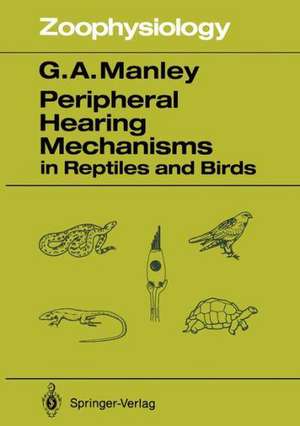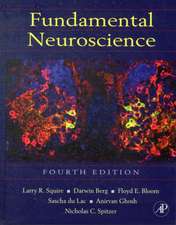Peripheral Hearing Mechanisms in Reptiles and Birds: Zoophysiology, cartea 26
Autor Geoffrey A. Manleyen Limba Engleză Paperback – 5 dec 2011
Din seria Zoophysiology
- 15%
 Preț: 647.92 lei
Preț: 647.92 lei - 15%
 Preț: 638.76 lei
Preț: 638.76 lei - 15%
 Preț: 638.24 lei
Preț: 638.24 lei - 15%
 Preț: 641.38 lei
Preț: 641.38 lei - 15%
 Preț: 634.82 lei
Preț: 634.82 lei -
 Preț: 386.61 lei
Preț: 386.61 lei - 15%
 Preț: 636.94 lei
Preț: 636.94 lei - 15%
 Preț: 640.88 lei
Preț: 640.88 lei - 15%
 Preț: 635.47 lei
Preț: 635.47 lei - 15%
 Preț: 637.78 lei
Preț: 637.78 lei - 15%
 Preț: 640.88 lei
Preț: 640.88 lei -
 Preț: 386.61 lei
Preț: 386.61 lei - 15%
 Preț: 637.78 lei
Preț: 637.78 lei - 15%
 Preț: 638.24 lei
Preț: 638.24 lei - 15%
 Preț: 642.83 lei
Preț: 642.83 lei - 15%
 Preț: 634.68 lei
Preț: 634.68 lei - 18%
 Preț: 999.60 lei
Preț: 999.60 lei - 15%
 Preț: 639.41 lei
Preț: 639.41 lei - 15%
 Preț: 638.43 lei
Preț: 638.43 lei - 15%
 Preț: 651.34 lei
Preț: 651.34 lei - 15%
 Preț: 638.57 lei
Preț: 638.57 lei - 15%
 Preț: 637.46 lei
Preț: 637.46 lei - 15%
 Preț: 637.59 lei
Preț: 637.59 lei - 15%
 Preț: 641.53 lei
Preț: 641.53 lei - 15%
 Preț: 636.80 lei
Preț: 636.80 lei -
 Preț: 386.22 lei
Preț: 386.22 lei - 15%
 Preț: 632.55 lei
Preț: 632.55 lei - 15%
 Preț: 695.19 lei
Preț: 695.19 lei -
 Preț: 401.24 lei
Preț: 401.24 lei - 18%
 Preț: 942.01 lei
Preț: 942.01 lei - 18%
 Preț: 945.30 lei
Preț: 945.30 lei - 15%
 Preț: 652.17 lei
Preț: 652.17 lei - 15%
 Preț: 632.70 lei
Preț: 632.70 lei - 15%
 Preț: 640.71 lei
Preț: 640.71 lei - 15%
 Preț: 644.30 lei
Preț: 644.30 lei - 15%
 Preț: 642.68 lei
Preț: 642.68 lei
Preț: 642.83 lei
Preț vechi: 756.27 lei
-15% Nou
Puncte Express: 964
Preț estimativ în valută:
123.00€ • 128.43$ • 101.80£
123.00€ • 128.43$ • 101.80£
Carte tipărită la comandă
Livrare economică 04-18 aprilie
Preluare comenzi: 021 569.72.76
Specificații
ISBN-13: 9783642836176
ISBN-10: 3642836178
Pagini: 304
Ilustrații: XII, 288 p.
Dimensiuni: 170 x 242 x 16 mm
Greutate: 0.49 kg
Ediția:Softcover reprint of the original 1st ed. 1990
Editura: Springer Berlin, Heidelberg
Colecția Springer
Seria Zoophysiology
Locul publicării:Berlin, Heidelberg, Germany
ISBN-10: 3642836178
Pagini: 304
Ilustrații: XII, 288 p.
Dimensiuni: 170 x 242 x 16 mm
Greutate: 0.49 kg
Ediția:Softcover reprint of the original 1st ed. 1990
Editura: Springer Berlin, Heidelberg
Colecția Springer
Seria Zoophysiology
Locul publicării:Berlin, Heidelberg, Germany
Public țintă
ResearchCuprins
1. Introduction.- 1.1 The Phylogeny of Reptiles and Birds.- 1.2 Systematics and the Inner Ear of Lizards.- 1.3 Cochlear Microphonics and the Inner Ear.- 2. Hair Cells and the Origin of the Hearing Inner Ear.- 2.1 Evolutionary Origin of the Inner Ear Sensory Epithelia.- 2.2 An Introduction to Hair Cells.- 2.3 Electroreceptors.- 2.4 Properties of Hair Cells of the Frog Sacculus.- 3. The Middle Ear.- 3.1 Origin of the Middle Ear.- 3.2 Pathways of Sound to the Inner Ear.- 3.3 General Functional Considerations.- 3.4 The Middle Ear as a Pressure-gradient Receiver.- 4. General Anatomical Considerations: Inner Ear and Basilar Papilla.- 4.1 Otic Labyrinth and Cochlear Duct.- 4.2 The Tectorial Membrane.- 4.3 The Basilar Papilla.- 5. Some Techniques Used in Hearing Research.- 5.1 Obtaining Reptiles.- 5.2 Anaesthesia and Surgery.- 5.3 Acoustic Stimulation.- 5.4 Measuring the Motion of Middle- and Inner Ear Structures.- 5.5 Recording the Electrical Activity of the Ear.- 5.6 Marking of Hair Cells and Nerve Fibres.- 5.7 Measuring Otoacoustic Emissions.- 5.8 Anatomical Studies of the Papilla.- 6. Turtles and Snakes.- 6.1 The Hearing Organ of the Red-eared Turtle Pseudemys (Chrysemys) scripta.- 6.2 The Hearing of Snakes.- 7. The Alligator Lizard and Granite Spiny Lizard.- 7.1 Anatomy of the Papilla Basilaris.- 7.2 Recordings from Hair Cells.- 7.3 Activity of Primary Auditory-nerve Fibres.- 7.4 Mechanics of the Basilar Papilla and Micromechanics of the Hair Cell Bundles.- 8. The European Lizards, Lacertidae: Podarcis sicula and Podarcis muralis.- 8.1 Anatomy of the Hearing Organ.- 8.2 Activity Patterns of Auditory-nerve Fibres.- 9. The Monitor Lizard, Varanus bengalensis.- 9.1 Anatomy of the Basilar Papilla.- 9.2 Activity Patterns of Primary Auditory Fibres.- 10. The Hearing of Geckos.-10.1 The Basilar Papilla of the Tokay Gecko, Gekko gecko.- 10.2 Activity of Afferent Auditory-nerve Fibres in Gekko.- 10.3 Temperature Effect on Tuning.- 11. The Bobtail Skink, Tiliqua rugosa.- 11.1 Anatomy of the Hearing Organ.- 11.2 Activity Patterns of Auditory-nerve Fibres.- 11.3 Basilar-membrane Mechanical Response and a Model of Frequency Tuning in Tiliqua.- 11.4 Seasonal Effects on Hearing.- 12. The Hearing of the Caiman, Caiman crocodilus.- 12.1 Anatomy of the Basilar Papilla.- 12.2 Mechanics of the Basilar Membrane.- 12.3 Otoacoustic Emissions from the Caiman Ear.- 12.4 Discharge Patterns of Primary Auditory-nerve Fibres.- 12.5 Effects of Temperature on Tuning.- 13. The Peripheral Hearing Organ of Birds.- 13.1 The Anatomy of the Cochlear Duct.- 13.2 Macromechanics of the Avian Cochlea.- 13.3 Otoacoustic Emissions from the Starling Cochlea.- 13.4 Activity of Auditory-nerve Fibres.- 14. Overview and Outlook.- 14.1 The Middle Ear and the Hearing Range.- 14.2 The Hearing Range and Papillar Development.- 14.3 Patterns in Spontaneous Activity.- 14.4 The Functions of the Tectorial Membrane.- 14.5 Specialization of Hair Cell Populations.- 14.6 Hair Cell Types and Innervation in Lizards.- 14.7 Frequency Selectivity of Vertebrate Auditory Receptors.- 14.8 Tonotopic Organization and its Evolution in Lizards.- 14.9 Mechanisms of Frequency Selectivity.- 14.10 Below and Above 1 kHz.- References.














